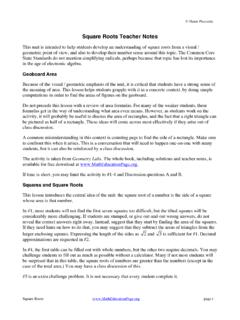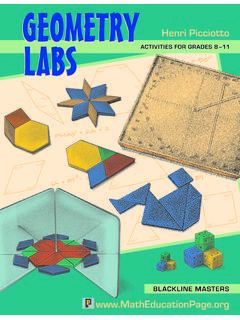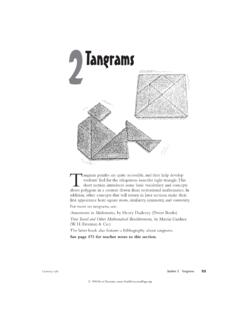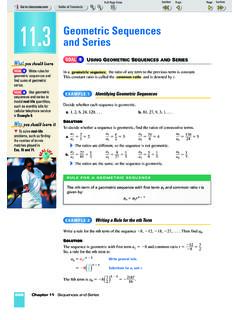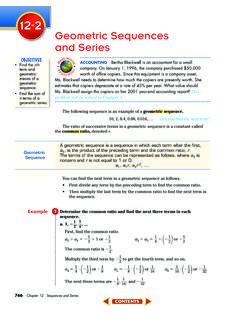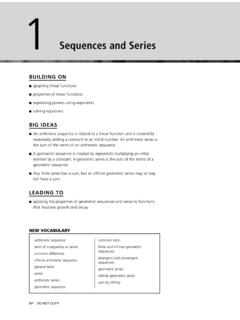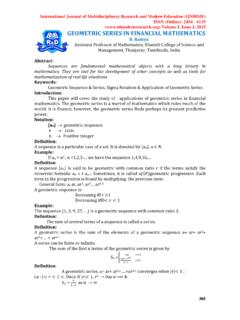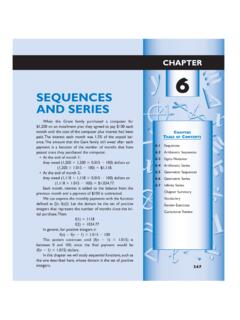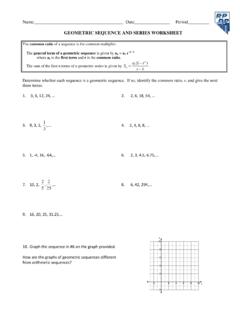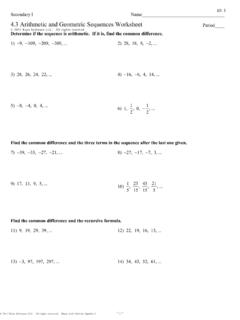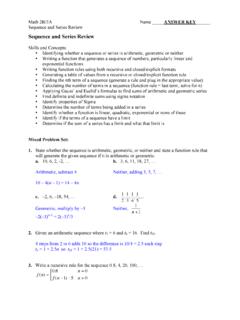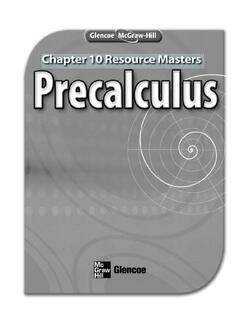Transcription of Geometric Sequences and Series - mathed.page
1 Geometric Sequences and Seriesp. 1 From Algebra: Themes, Tools, Concepts, by Anita Wah and Henri Picciotto, Teacher s GuideGeometric Sequences and SeriesThese lessons offer a number of interesting problems to explore Geometric Sequences and Series . Theirmain strength is the use of an algorithmic rather than formulaic approach to finding the sum ofgeometric lessons and these notes are slightly edited from Algebra: Themes, Tools, Concepts, by Anita Wahand Henri Picciotto. More information on this book can be found at: Sequences as FunctionsCore sequence : 1-13 Suitable for homework: 5-13 Useful for Assessment: 13 What this Lesson is About: Preview of Geometric Sequences Review of arithmetic Sequences Linear, quadratic, and exponential functions and their graphs Preview of slopeThis assignment is intended to focus students attention on a functional interpretation of Sequences . Inparticular, students should see that arithmetic Sequences correspond to linear mystery Sequences in #11 are quadratic.
2 The numerical pattern that relates consecutive terms insuch Sequences can be expressed in various ways. One way is to state that the differences betweenconsecutive terms form an arithmetic common difference is visible in the graphs of arithmetic Sequences as the rise betweenconsecutive points. This previews or reviews Sums of Geometric SequencesCore sequence : 3-10 Useful for Assessment: 8, 10 What this Lesson is About: Review of comparing by ratio and comparing by difference Review of Geometric Sequences Sums of Geometric Sequences Application of Geometric Sequences to the distance traveled by a bouncing ballGeometric Sequences and Seriesp. 2 From Algebra: Themes, Tools, Concepts, by Anita Wah and Henri Picciotto, Teacher s GuideThe Bouncing BallThe experiment in #1-2 is optional, but it greatly increases students interest in the lesson. It alsoserves to review comparing by ratio vs comparing by difference.
3 The result of the experiment shouldbe to observe that (even taking measurement error into account) the ratio is much more constant thanthe difference.#3-5 should give students a chance to get some experience with the basic problem of the lesson. Theywill use their calculators to answer the #4, make sure students include the travel in both directions. It is easy to make a calculating mistakein #4b, but students should get answers that are close to each others , since the terms get smaller andsmaller. Do not attempt 4b without a calculator!They should be able to make fairly good guesses for #5, either by using their calculators or by makingan estimate based on the observation that the terms get smaller and smaller. It is not important for theguess to be Finding the SumCore sequence : 1-8 Suitable for homework: 6-8 Useful for Assessment: 8, 10-11, 15, 21-22 What this Lesson is About: Review of comparing by ratio and comparing by difference Review of Geometric Sequences Sums of Geometric Sequences Application of Geometric Sequences to the distance traveled by a bouncing ballThe terms Geometric sequence and common ratio were introduced in Lesson point of this lesson is not to introduce the formula for the sum.
4 There is more gained at this levelby students using algebraic manipulation when calculating the sum, than efficiently calculating thesum with a formula. Students at this level do not have the maturity to keep in mind both the formulaand its derivation. Moreover, it is easy to apply the formula incorrectly because of not rememberingwhether to use n-1, or n, or n+1 in a given problem. Finally, formula-wielding students often confusethe formula for the nth term with the formula for the sum.(Any student who is actually conceptually ready to use the formula will be able to do it after thislesson.)Note that each ball bouncing problem includes the calculation of two sums of Geometric Sequences ,with the second term of one being the first term of the other. This forces students to keep alert and toremember what they are Sequences and Seriesp. 3 From Algebra: Themes, Tools, Concepts, by Anita Wah and Henri Picciotto, Teacher s GuideYou may want to introduce the multiply-subtract-solve technique at the chalkboard, before lettingstudents work on # Decimals and FractionsCore sequence : 1-11 Suitable for homework: 8-11 Useful for Assessment: 5, 9 What this Lesson is About: Review of converting fractions to decimals Converting decimals to fractionsThis lesson is mostly an application to decimals-fractions conversion of the previous lesson on sums ofgeometric Sequences .
5 Writing Fractions as Decimals#1-2 can be solved with the help of a calculator, however students should be reminded that the limiteddisplay of the calculator is not the most appropriate place to study the questions we address in thissection, since the decimal expansion may terminate or repeat beyond the level of accuracy allowed bythe calculator. The key idea is that remainders whose prime factors (in lowest terms) are exclusively 2and 5 will terminate. All others will repeat.#3-4 require the use of long division. The basic idea is that only so many remainders are they have all been used, the expansion must terminate or repeat. A full answer to #3 is difficult,but some partial answers are: if the denominator is d, the length of the repeating string must be < d. in fact, the length of the repeating string is often a factor of (d-1).#5 is an opportunity to distinguish between a decimal approximation and a decimal representation for agiven Decimals as FractionsYou should probably demonstrate on the chalkboard how to apply the multiply-subtract-solvetechnique to the conversion of repeating decimals to More PracticeRational Numbers# can be answered by using the multiply-subtract-solve technique.
6 However, do not do not beconcerned if some students do not find the argument convincing. A real understanding of limitsrequires more mathematical Sequences and Seriesp. 4 From Algebra: Themes, Tools, Concepts, by Anita Wah and Henri Picciotto, Teacher s GuideBounce RatiosThis section will allow students to practice what they have learned, but also to think about thedifference between a common ratio r such that r!<!1, and one such that r do not need to formally define convergence. At this level, all students need to realize is that thehigher the exponent of r (if r<1), the smaller the corresponding will be more applications of sums of Geometric Sequences in the following lessons. In addition,you can go back to the problems in Chapter 2, Lesson 5 and Chapter 7, Lesson 8.
